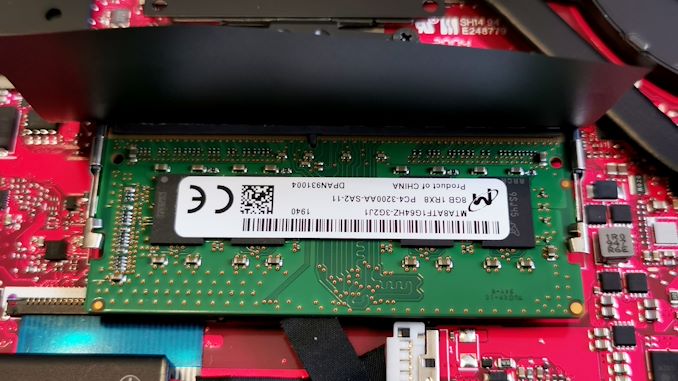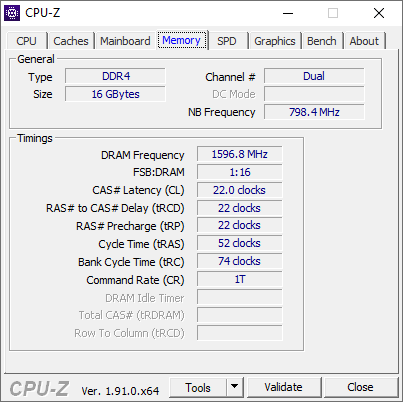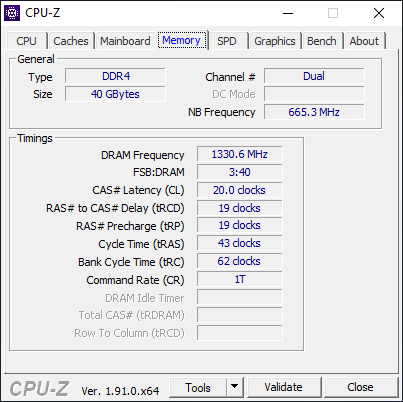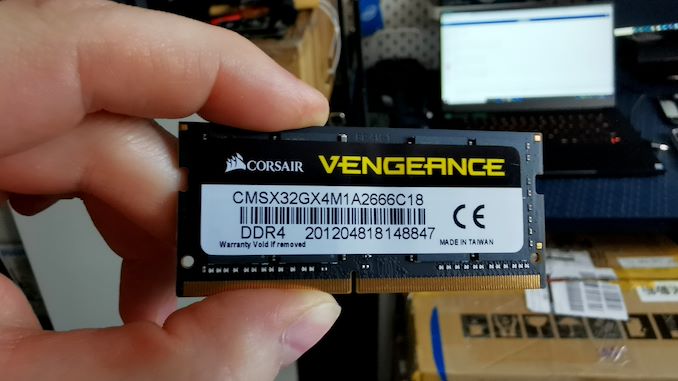AMD’s Mobile Revival: Redefining the Notebook Business with the Ryzen 9 4900HS (A Review)
by Dr. Ian Cutress on April 9, 2020 9:00 AM ESTRyzen 9 4900HS with DDR4-2666 and DDR4-3000
In our ASUS Zephyrus G14, we have a total of 16 GB of DDR4. This is split between a single SO-DIMM module of 8 GB, and a set of 8 GB memory soldered onto the board. AMD will offer a version with 16 / 16, however this might come at a later date.
This memory is running at the AMD recommended for these processors, DDR4-3200. Through our inspection tools, we can tell that this memory is running with subtimings of 22-22-22 with a command rate of 1T. The command rate is certainly good, however the 22-22-22 is a little slower than what we see on a desktop system running at this speed, because here we have a system that conforms to JEDEC’s subtiming requirements.
For our memory testing we wanted to see what speeds and capacities we could achieve. Corsair very kindly sent us some modules of 16 GB DDR4-3000 and a module of 32 GB DDR4-2666. This would give our system either 24 GB or 40 GB total respectively, which for a machine designed to do heavier duty workloads, having >16 GB is certainly welcome, as long as the performance hit isn’t too much.
I installed the 32 GB module, and the system booted first time with no fuss. A quick look to see if all the capacity was seen, and we had a total of 40 GB. The speed was also as expected, at DDR4-2666 but with subtimings of 20-19-19 1T.
However, when we put in the module of 16 GB DDR4-3000, to get a total of 24 GB, the detected speed inside the system was only DDR4-2666. Looking at the module settings, this was because the DDR4-3000 speed was actually an XMP profile, and ASUS has not enabled the ability to set XMP profiles here.
We were able to get DDR4-2666 on the 32 GB module because this is the base frequency and settings for the module. The same with the 8 GB module that came with the system – it was flashed so that the basic SPD setting was DDR4-3200. If users want to get high capacity modules with the faster DRAM speeds on this system, they will have to configure the primary SPD profile of their modules, which isn’t an easy thing to do.
As a result, our tests are going to come down to the 8 GB DDR4-3200 module that came with the system, and compare it to the 32 GB DDR4-2666 module. Note that the latter is an 8+32 configuration, which is expected to run in dual channel for the first 16 GB, and then single channel for the next 24 GB.



With our AI test, there’s a ~20% benefit from having the faster memory, which decreases slightly when moved to a limited power budget.

We didn’t see any difference in something like Cinebench.

There was more of a difference in PCMark 10, however PCM10 isn't that great in showing where the bottlenecks are.
Integrated Graphics Tests


For the Civ 6 graphics test, the difference in performance between the two memory settings is really significant. This sort of game cares less about FPS, however going down to 22 FPS for 1080p Max and No MSAA means that the user probably has to dial that back a bit to get something more reasonable.


Going from plugged in to not plugged in, we didn’t see much of a change with the slower memory, however the DDR4-3200 setting still gets a serious benefit over the DDR4-2666 arrangement.

For Final Fantasy, there a significant change - moving up from DDR4-2666 to DDR4-3200 affords a +30% improvement.
Discrete Graphics Tests




In each case, the faster DRAM actually improves discrete graphics performance.
Quick Thoughts
Overall, 16 GB of memory in a system like this isn't the best configuration - people who need the power are going to likely want 32 GB. However, users putting in their own fast module when buying the 16 GB version are going to have to be careful about the performance. Both the integrated graphics and the discrete graphics take a knock on performance going down from DDR4-3200 to DDR4-2666.















267 Comments
View All Comments
twtech - Friday, April 10, 2020 - link
That picture really illustrates just how gigantic the 64 core TR/Epyc really is.Keyboard1701 - Friday, April 10, 2020 - link
Going by the performance of the laptops on battery, I'm curious to see if something like a gtx 1650 might actually perform better than a rtx 2060 on battery.Keyboard1701 - Friday, April 10, 2020 - link
I apologise for the double post, but I've also observed that the iGPU actually performs just as well as the rtx 2060 when the laptop is running on battery. Would this mean that the discrete gpu is redundant for someone who mainly intends to use the laptop on battery power?RollingCamel - Friday, April 10, 2020 - link
Did you run any thermal analysis on the laptop?DanNeely - Friday, April 10, 2020 - link
IF you do any more tests on this, I'd be interested in seeing how gaming performance is affected by using a 65W USB-C charger instead of the 180W barrel one. The smaller charger would be nice while traveling; but the only time I'd be gaming on a laptop is when I'm away and don't have access to my desktop.willgart - Friday, April 10, 2020 - link
the performance gain by changing the RAM is incredible.DiHydro - Friday, April 10, 2020 - link
Thank you taking the time to look at and comment on the thickness, and how it allows a bigger battery in the same footprint. I have been saying for the past couple years how the race for the thinnest laptop is pretty futile when OEMs keep putting higher wattage parts in them.velatra - Friday, April 10, 2020 - link
There's a problematic sentence in the second paragraph of the "2016: A Historic Low for AMD in Notebooks" section of the first page. It reads "OEMs knew this crippled performance, but in enabled the headline processors...." Perhaps "in" should be "it."Techie2 - Saturday, April 11, 2020 - link
Nice to see AMD continuing to lead in performance. One thing that makes no sense to me is pricing on laptops. I just don't see the basis for >$1000. laptops. It's not like the hardware cost can justify the retail prices. It's more like collusion by laptop makers IMO. I guess when they finally saturate the laptop market prices will come down to reality.watzupken - Saturday, April 11, 2020 - link
AT has done a great job with this review. Where I think AT did a lot better than the rest of the reviewers (besides the usual technical analysis), is that you nailed the issue with the short battery life that left many perplexed since some review sites are getting 10+ hours of battery, while some are getting 4+. I think its a good testament of the knowledge of the reviewers here. Thank you AT.